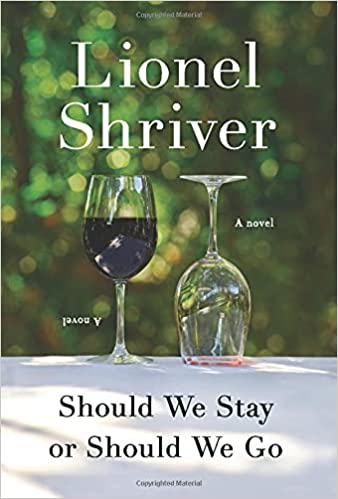Lionel Shriver
HarperCollins Publishers
New York
2121
266 pages
According to the Art:
The book has entertainment value, to be sure. Readers of a certain age will further appreciate the book for the questions it raises and the thinking it inspires about taking measures to avoid devastating enfeeblement and infirmity during old age.
Synopsis:
Cyril Wilkinson and his wife Kay make a pact. On Kay’s eightieth birthday, when Cyril is already eighty-one, they will commit suicide together. Cyril, a physician in the British National Health Service (NHS) secured a supply of secobarbital as the means to their end. It was 1991. They have planned well ahead; another twenty-nine years will pass before Kay’s eightieth in 2020.
Motivating the pact was the death of Kay’s father after “a good four years of steady deterioration, followed by a solid ten of nothing but degradation” from dementia from. (p 7) They had just arrived home from his funeral service, and were reflecting on what they had been through. At one point, Cyril says, “Your father frankly made me suicidal—or homicidal—or both. Half an hour in his presence passed like a mini ice age,” and then promises Kay, “I will do almost anything to keep the two of us from acceding to such a fate.” (p. 12) But Kay is dubious.
That’s what everyone says…Everyone looks at what happens to old people and vows that it will never happen to them…Somehow they’ll do something so their aging will proceed with dignity…Everyone thinks they have too much self-respect to allow a stranger to wash their private parts…Then it turns out that, lo and behold, they’re exactly like everyone else! And they fall apart like everyone else, and finish out their miserable end of their lives like everyone else.
pp. 12-13
And so Kay dithers over the next few months whether to agree to the pact, but then her mother begins showing signs of dementia; “I’m all in,” she tells Cyril. (p. 17)
Cyril and Kay proceed through the subsequent twenty-nine years, with Kay raising their three children, retiring, finding new work and passions; Cyril going on and on about politics, the NHS, old people; and both watching their remaining parents pass on, traveling to far-flung locations, becoming grandparents, aging. Then the day arrives; happy birthday, Kay?
The novel structure is simple or complex depending on how a reader approaches it. The first chapter sets up the pact. The second chapter leads up to the day of reckoning and becomes the first story telling what became of the Wilkinsons’ plan. The next eleven chapters envision alternative scenarios unfolding from choices Cyril and Kay make before and on their pre-determined end date. Some scenarios stem from one or both of them not going through with their pact. Some scenarios involve recognizable and available options today, and some are wholly futuristic and unattainable. Some scenarios are happy, some are sad, all are unsettling. These chapters can read as independent stories offering different choices and endings. But they can also be read as interdependent and collectively building toward a point of view on the question: Should we stay or should we go?
The interdependence and complexity of the chapters arise from the through lines among them. From the third chapter on, for example, the first few sentences of each chapter are taken verbatim or slightly modified from some part of a preceding chapter, and serve as jumping-off points. Other blocks of text appear in one or more chapters. One through line even extends beyond the book to another of Shriver’s novels (So Much For That). Kay and Cyril exhibit the same personalities and preferences, and express the same general hopes and desires through all the chapters. Other through lines are shared events or recurring arguments and debates; however, not always with the same outcomes.
The four years preceding Kay’s eightieth birthday overlap both the decision of the United Kingdom (UK) to leave the European Union (“Brexit”) and the Coivd-19 pandemic. Thus, during the time Cyril and Kay are deciding whether they will actually leave or remain on Earth, the UK is deciding whether to leave or remain in the European Union, and while Cyril and Kay are seemingly willing to die rather than fight the ravages of old age, millions of people are willing to fight the ravages of Covid-19 rather than die. These juxtapositions pop up often giving the Wilkinsons’ decision added poignancy.
Analysis:
The book has entertainment value, to be sure. Readers of a certain age will further appreciate the book for the questions it raises and the thinking it inspires in primarily two ways. First, Shriver tells how searing and excruciating caring for someone with dementia can get for family and caregivers. Second, she envisions the consequences people may face when taking measures to avoid devastating enfeeblement and infirmity during old age.
In establishing the Wilkinsons’ motivation for their pact, Shriver’s descriptions of their experience caring for Kay’s father are unsparing.
He was physically so unpleasant as well. My mother and I tried, but managing the nappies alone was such a trial, because he fought and kicked a great deal, and sometimes, which was mortifying, got a soft little erection—honestly, my own father. So we’d put off changing him, and he often smelt. (pp. 2-3)
I can’t tell you how awkward it is to brush someone else’s teeth, and then he’d bite…The chasing and corralling and undressing…I was halfway between a daughter and a sheepdog. The eternal surveillance, because we had to watch him like a two-year-old, lest he cut himself, or drink Fairy Liquid, or set the house on fire…The spoon-feeding, the wiping the muck from his beard…The cajoling, for hours on end, to coax him down from the ladder to the loft, of all places… (p. 6)
I can’t control the pictures that pop in my head. Naked below the waist, purple with rage, and covered in feces: one of my favorites. (p. 9)
These and similar episodes make the Wilkinsons’ pact seem rational. “In order to retain agency over your own end of life, you have to be willing to give up some small portion of it that’s not particularly rubbish,” Cyril’s reasons. (p. 31) But, he admits their plan amounts to “placing a high-stakes wager.” (p. 32) Through the twelve different endings Shriver creates, we see if their wagers are well placed, and if their pact was as reasonable in practice as it seemed in theory.
For each path the Wilkinsons take, Shriver concentrates on how their wagers play out. I won’t spoil the endings, but from these tales I can highlight insights on common and contemporary issues concerning aging, as well as on some hypothetical and futuristic possibilities. Among them are these:
- The surprises still left between people after more than forty years of marriage
- The possibility of a person with dementia as happy
- Whether being sensible and prepared for old age is always rewarding
- The prospect of outliving enjoyment, purpose, or interest in life
- What life might be like when a drug reverses aging and makes elderly people twenty-five years old again, forever
- Elder abuse within an institution and within a family
- The adventurousness and desperation people approaching old age can exhibit
None of the alternative paths stands out as the one to follow. Shriver, though, offers other ways of accommodating the challenges and frights of approaching old age. Throughout the chapters, and with mostly dialog between Cyril and Kay as they think through their choices and decisions, she puts an emphasis on destiny, risk, and bravery.
When Kay is arguing against the pact, she tries to impress upon Cyril that destiny has a part in what becomes of them, and that they cannot control all of it. “Our destiny isn’t wholly in our hands. I realize you don’t like that about the world, but there’s an upside: our destiny isn’t wholly our responsibility, either. Or, if we end badly, our fault.” (p. 241) Shriver emphasizes the point by making destiny a component of each alternative path they take. Destiny can’t be completely controlled, so embrace it, or at least accept it, Shriver may be saying.
The decision to end their lives on Kay’s eightieth birthday is not the only gamble they make. As they course through all of the alternative paths, Cyril and Kay make decisions that come with risks and are bets on their futures. Kay acknowledges this reality when she asks Cyril, “every decision we make is a gamble, isn’t it?” (p. 202) It’s the case long before old age, Kay seems to be saying.
The pact Cyril and Kay make can seem brave, but Shriver is not having it, and especially not when compared to the bravery needed in old age. “Real bravery and nobility,” Kay tells Cyril, “entail losing everything you love by degrees like everyone else, and taking what comes like everyone else, and dying when you least expect it and when you don’t want to, like everyone else.” (p. 75) “Buck up,” Shriver could have added.
We should stay: it’s destiny, with risks, be brave.
Also:
A version of this post is here at the NYU Literature, Arts and Medicine Database.



